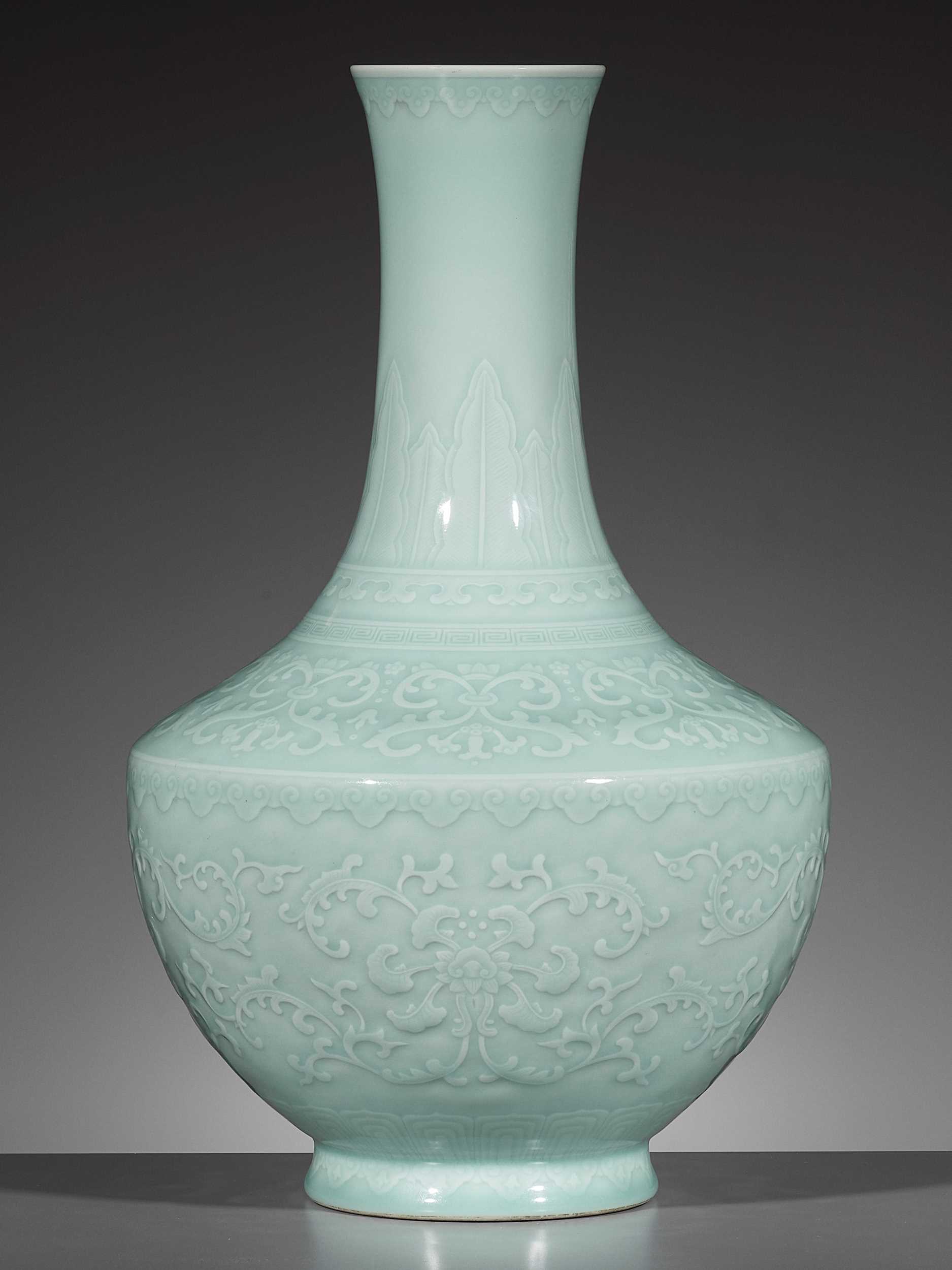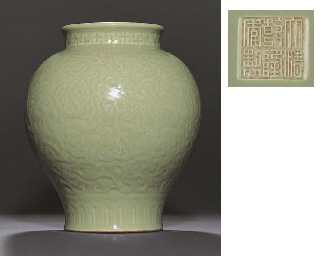Lot details China, 1736-1795. Finely carved in high relief around the body with stylized lotus flowerheads borne on scrolling leafy vines, overall incised with minute details, above a lappet border and below a band of ruyi heads. The shoulder similarly decorated with foliate scroll below a distinct leiwen border, the neck with overlapping palm blades above pendent trefoils, with further ruyi bands at the foot and below the rim. The base incised with a six-character seal mark da Qing Qianlong nianzhi in intaglio within a slightly recessed square and of the period. Provenance: West Berkshire, United Kingdom, local trade. By repute acquired from a private estate. Condition: Excellent condition with minor old wear and firing flaws, tiny surface scratches. Weight: 3,097 g Dimensions: Height 38.3 cm The rounded sides supported on a spreading foot and sweeping up to an angular shoulder and waisted neck. Covered overall in a lustrous sea-green glaze pooling to a rich and deep celadon tone within the carved recesses. The base and inside glazed as well, leaving only the foot rim unglazed, revealing the white biscuit. From its fine potting, translucent pale green celadon glaze, crisp lotus scroll and supporting designs, this vase reveals the technical and artistic virtuosity of craftsmen active at the Imperial kilns in Jingdezhen during the 18th century. The form evokes a sense of effortless elegance, despite its design being meticulously executed and conceived in advance. The decoration and glaze both draw from the celebrated ceramic tradition of Longquan in Zhejiang province and reinterpret it to suit the eclectic taste of the 18th century and growing interest in timeless elegance, literally overarching millennia. Celadon-glazed wares are perhaps the type of ceramics most intimately associated with China. Their origins can be traced back to the Bronze Age, and since then they continued to be popular throughout the Chinese empire. The brilliant bluish-celadon glazes created at the Longquan kilns had provided much inspiration to the potters of the Jingdezhen imperial kilns since the early Ming dynasty. By lessening the amount of iron in the glaze, the potters were able to create a cool and delicate celadon glaze that, when applied on a white porcelain body, resembled the translucency and texture of pale celadon jade. A wide range of exquisite celadon tones was created in the early Qing dynasty, as a result of the Yongzheng and Qianlong Emperors’ appreciation of Song dynasty porcelain. Much admired by contemporary connoisseurs was the douqing (bean-green), a bright sea-green color, and the present fenqing (soft green), a pale celadon-green glaze. When applied to finely carved pieces as on the present vase, the thinning and pooling of the glaze on the raised lines and the recesses create a delicate shaded effect, thus accentuating the crispness of the design. The present vase belongs to a group of monochrome wares where, by using a multi-level carving technique, the craftsmen have created a contrast in the color tone, as if two shades of the same color were used. The motif is elaborate and complex, displaying a level of porcelain carving and incision quality only achieved in the Imperial kilns of the 18th century, yet without any cluttering or overload whatsoever. The elegant silhouette of this vase, its restrained decoration, subtle glaze, and intaglio mark suggest that it was made in the early to middle years of the Qianlong reign, some time before designs slowly started to become overtly elaborate. Expert’s note: The luxuriant lotus scroll on the present vase, which is particularly crisp in its rendering, was adapted from the somewhat rough and rustic designs on Longquan celadons of the Yuan and Ming dynasties. By adding tall palm blades to the neck, precise ruyi borders to the edges, multi-layer lappets to the lower body, and a hyper-accurate leiwen band to the shoulder, the artist has sensibly transitioned original Longquan designs in
Lot details China, 1736-1795. Finely carved in high relief around the body with stylized lotus flowerheads borne on scrolling leafy vines, overall incised with minute details, above a lappet border and below a band of ruyi heads. The shoulder similarly decorated with foliate scroll below a distinct leiwen border, the neck with overlapping palm blades above pendent trefoils, with further ruyi bands at the foot and below the rim. The base incised with a six-character seal mark da Qing Qianlong nianzhi in intaglio within a slightly recessed square and of the period. Provenance: West Berkshire, United Kingdom, local trade. By repute acquired from a private estate. Condition: Excellent condition with minor old wear and firing flaws, tiny surface scratches. Weight: 3,097 g Dimensions: Height 38.3 cm The rounded sides supported on a spreading foot and sweeping up to an angular shoulder and waisted neck. Covered overall in a lustrous sea-green glaze pooling to a rich and deep celadon tone within the carved recesses. The base and inside glazed as well, leaving only the foot rim unglazed, revealing the white biscuit. From its fine potting, translucent pale green celadon glaze, crisp lotus scroll and supporting designs, this vase reveals the technical and artistic virtuosity of craftsmen active at the Imperial kilns in Jingdezhen during the 18th century. The form evokes a sense of effortless elegance, despite its design being meticulously executed and conceived in advance. The decoration and glaze both draw from the celebrated ceramic tradition of Longquan in Zhejiang province and reinterpret it to suit the eclectic taste of the 18th century and growing interest in timeless elegance, literally overarching millennia. Celadon-glazed wares are perhaps the type of ceramics most intimately associated with China. Their origins can be traced back to the Bronze Age, and since then they continued to be popular throughout the Chinese empire. The brilliant bluish-celadon glazes created at the Longquan kilns had provided much inspiration to the potters of the Jingdezhen imperial kilns since the early Ming dynasty. By lessening the amount of iron in the glaze, the potters were able to create a cool and delicate celadon glaze that, when applied on a white porcelain body, resembled the translucency and texture of pale celadon jade. A wide range of exquisite celadon tones was created in the early Qing dynasty, as a result of the Yongzheng and Qianlong Emperors’ appreciation of Song dynasty porcelain. Much admired by contemporary connoisseurs was the douqing (bean-green), a bright sea-green color, and the present fenqing (soft green), a pale celadon-green glaze. When applied to finely carved pieces as on the present vase, the thinning and pooling of the glaze on the raised lines and the recesses create a delicate shaded effect, thus accentuating the crispness of the design. The present vase belongs to a group of monochrome wares where, by using a multi-level carving technique, the craftsmen have created a contrast in the color tone, as if two shades of the same color were used. The motif is elaborate and complex, displaying a level of porcelain carving and incision quality only achieved in the Imperial kilns of the 18th century, yet without any cluttering or overload whatsoever. The elegant silhouette of this vase, its restrained decoration, subtle glaze, and intaglio mark suggest that it was made in the early to middle years of the Qianlong reign, some time before designs slowly started to become overtly elaborate. Expert’s note: The luxuriant lotus scroll on the present vase, which is particularly crisp in its rendering, was adapted from the somewhat rough and rustic designs on Longquan celadons of the Yuan and Ming dynasties. By adding tall palm blades to the neck, precise ruyi borders to the edges, multi-layer lappets to the lower body, and a hyper-accurate leiwen band to the shoulder, the artist has sensibly transitioned original Longquan designs in

.jpg)








.jpg?w=400)




Testen Sie LotSearch und seine Premium-Features 7 Tage - ohne Kosten!
Lassen Sie sich automatisch über neue Objekte in kommenden Auktionen benachrichtigen.
Suchauftrag anlegen